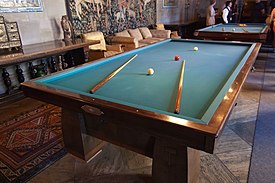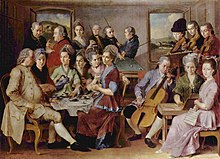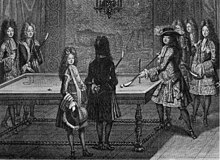
Cue sports are a wide variety of games of skill played with a cue, which is used to strike billiard balls and thereby cause them to move around a cloth-covered table bounded by elastic bumpers known as cushions. Cue sports are also collectively referred to as billiards, though this term has more specific connotations in some varieties of English.

English billiards, called simply billiards in the United Kingdom and in many former British colonies, is a cue sport that combines the aspects of carom billiards and pool. Two cue balls and a red object ball are used. Each player or team uses a different cue ball. It is played on a billiards table with the same dimensions as one used for snooker and points are scored for cannons and pocketing the balls.

Straight pool, which is also called 14.1 continuous and 14.1 rack, is a cue sport in which two competing players attempt to pocket as many object balls as possible without playing a foul. The game was the primary version of pool played in professional competition until it was superseded by faster-playing games like nine-ball and eight-ball in the 1980s.

A billiard ball is a small, hard ball used in cue sports, such as carom billiards, pool, and snooker. The number, type, diameter, color, and pattern of the balls differ depending upon the specific game being played. Various particular ball properties such as hardness, friction coefficient, and resilience are important to accuracy.

Russian pyramid, also known as Russian billiards, is a form of billiards played on a large billiard table with narrow pockets. It is played across Russia and several former Soviet/Eastern Bloc countries. In the West, the game is known as pyramid billiards, or simply pyramid.

Straight rail, also called straight billiards, three-ball billiards, or the free game, is a discipline of carom billiards that is the most basic form of the game. The game is played on a pocketless unmarked billiard table, usually 10 by 5 feet in size, and three billiard balls, one, usually white, that serves as the cue ball for the first player, a second cue ball for the second player, and an object ball, usually red. The object of the game is to score points by striking the player's assigned cue ball with a cue stick so it makes contact with both the opponent's cue ball and the object ball in the same stroke, known as a carom. Games are played to a predetermined number of points.

A billiard table or billiards table is a bounded table on which cue sports are played. In the modern era, all billiards tables provide a flat surface usually made of quarried slate, that is covered with cloth, and surrounded by vulcanized rubber cushions, with the whole thing elevated above the floor. More specific terms are used for specific sports, such as snooker table and pool table, and different-sized billiard balls are used on these table types. An obsolete term is billiard board, used in the 16th and 17th centuries.

Pool is a classification of cue sports played on a table with six pockets along the rails, into which balls are shot. Each specific pool game has its own name; some of the better-known include eight-ball, blackball, nine-ball, ten-ball, seven-ball, straight pool, one-pocket, and bank pool. Eight-ball is the most frequently played discipline of pool, and is often thought of as synonymous with "pool".

Four-ball billiards or four-ball carom is a carom billiards game, played on a pocketless table with four billiard balls, usually two red and two white, one of the latter with a spot to distinguish it. Each player is assigned one of the white balls as a cue ball. A point is scored when a shooter's cue ball caroms on any two other balls in the same shot. Two points are scored when the shooter caroms on each of the three object balls in a single shot. A carom on only one ball results in no points, and ends the shooter's inning.
The following is a glossary of traditional English-language terms used in the three overarching cue sports disciplines: carom billiards referring to the various carom games played on a billiard table without pockets; pool, which denotes a host of games played on a table with six pockets; and snooker, played on a large pocket table, and which has a sport culture unto itself distinct from pool. There are also games such as English billiards that include aspects of multiple disciplines.
Cowboy pool is a hybrid pool game combining elements of English billiards through an intermediary game, with more standard pocket billiards characteristics. The game employs four balls, the cue ball and three others, numbered one, three, and five. A game of Cowboy pool is contested as a race to 101 points, with those points being awarded for a host of different shot types. Dating back to 1908, the game is a strictly amateur pastime.

Three-cushion billiards, also called three-cushion carom, is a form of carom billiards. The object of the game is to carom the cue ball off both object balls while contacting the railcushions at least three times before contacting the second object ball. A point is scored for each successful carom. In most shots the cue ball hits the object balls one time each, although hitting them any number of times is allowed as long as both are hit. The cue ball may contact the cushions before or after hitting the first object ball. It does not have to contact three different cushions as long as it has been in contact with any cushion at least three times in total.
Honolulu, also known as banks, kisses, and combinations or indirect, is a pocket billiards game. Players must pocket all shots in an indirect fashion to reach a set number of points. The game shares some similarities with other cue sports, played on tables and with balls used for pool, but differs with foul points being awarded for regular direct shots.

Balkline is the overarching title of a group of carom billiards games generally played with two cue balls and a red object ball on a cloth-covered, 5 foot × 10 foot, pocketless billiard table. The object of the game is to score points, also called counts, by a player striking their cue ball so it makes contact with both the opponent's cue ball and the object ball on a single stroke. A player wins the game by reaching a predetermined number of points. The table is divided by lines drawn on the surface, called balklines, into marked regions called balk spaces. Balk spaces define areas of the table surface in which a player may only score up to a threshold number of points while the opponent's cue ball and the object ball are within that region.
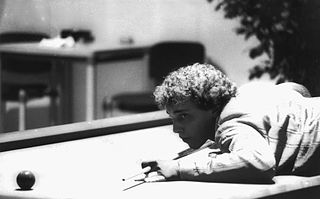
One-cushion billiards also known as cushion caroms is a carom billiards discipline generally played on a cloth-covered, 10-by-5-foot, pocketless billiard table with two cue balls and a third red-colored ball. In a one-cushion shot, the cue ball caroms off both object balls with at least one rail being struck before the hit on the second object ball. The object of the game is to score up to an agreed upon number of cushion caroms, with one point being awarded for each successfully made. If no object ball is contacted, one point is deducted. If there is ambiguity as to whether the second ball was contacted, it is resolved against the shooter. It is governed by the Union Mondiale de Billard, the world governing body of carom billiards.

Five-pin billiards or simply five-pins or 5-pins, is today usually a carom billiards form of cue sport, though sometimes still played on a pocket table. In addition to the customary three balls of most carom games, it makes use of a set of five upright pins (skittles) arranged in a "+" pattern at the center of the table. The game is popular especially in Italy and Argentina, but also in some other parts of Latin America and Europe, with international, televised professional tournaments. It is sometimes referred to as Italian five-pins or Italian billiards, or as simply italiana. A variant of the game, goriziana or nine-pins, adds additional skittles to the formation. A related pocket game, with larger pins, is played in Scandinavia and is referred to in English as Danish pin billiards, with a Swedish variant that has some rules more similar to the Italian game.
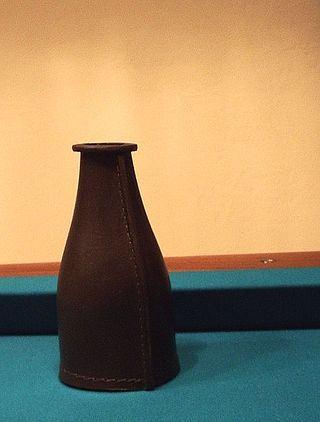
Bottle pool, also known as bottle-billiards and bottle pocket billiards, is a hybrid billiards game combining aspects of both carom billiards and pocket billiards. Played on a standard pool table, the game uses just two object balls, a cue ball, and a 6+3⁄4 inches (170 mm) tall, narrow-necked bottle called a shake bottle or tally bottle, traditionally made from leather, that is placed on the table and used as a target for caroms. Those unfamiliar with the game sometimes mistakenly use its name as a synonym for the very different game of kelly pool. Bottle pool has been described as combining "elements of billiards, straight pool and chess under a set of rules that lavishly rewards strategic shot making and punishes mistakes with Sisyphean point reversals."

The Union Mondiale de Billard is the world governing body for carom (carambole) billiard games.
Carom billiards and pool are two types of cue sports or billiards-family games, which as a general class are played with a stick called a cue which is used to strike billiard balls, moving them around a cloth-covered billiard table bounded by rubber cushions attached to the confining rails of the table.
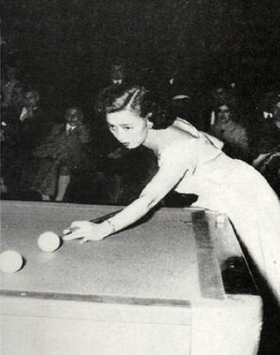
Masako Katsura, nicknamed "Katsy" and sometimes called the "First Lady of Billiards", was a Japanese carom billiards player who was most active in the 1950s. She was the first woman to compete and place among the best in the male-dominated world of professional billiards. First learning the game from her brother-in-law and then under the tutelage of Japanese champion Kinrey Matsuyama, Katsura became Japan's only female professional player. In competition in Japan, she took second place in the country's national three-cushion billiards championship three times. In exhibition she was noted for running 10,000 points at the game of straight rail.
